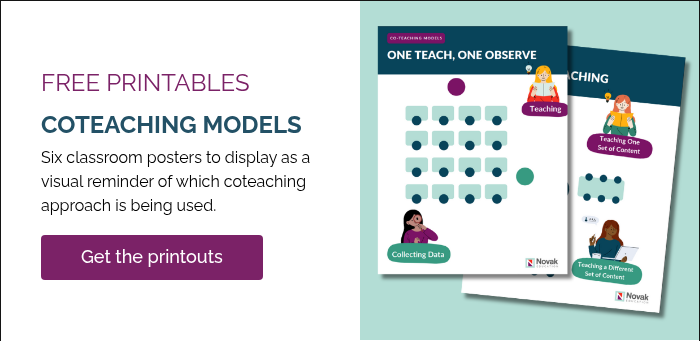Real-World Tips (and Free Printables!) to Help Two Teachers Work as One
Picture it. Orange County, California. 1999. (Who is here for the Golden Girls reference??). As a brand new Special Education teacher, I walked into my first general education classroom to co-teach. The teacher didn’t want me there, and she definitely didn’t want my students there either. As I approached this veteran teacher with more than 25 years of teaching experience, I remember taking a deep breath and encouraging myself, “You can do this, Pam!”. I smiled and then let the teacher know that I would hang out in the back of the room and help kids that needed assistance. She seemed relieved that this newbie teacher wouldn’t get in her way. And that, friends, is how my first month of co-teaching went: Pam fades to the back while the experienced professional keeps doing what she has always done.
Fast forward a few months. This teacher and I got to know each other. I felt more comfortable suggesting ideas. She even asked me to teach a lesson to the whole class while she helped kids in the back. What changed? Patience and relationship building? Sure. But the thing that made the biggest impact was her seeing my previously self-contained students with disabilities start shining in her class. She went from “YOUR kids can’t do this so make sure you help them keep up” to “I think all of OUR kids would benefit from this strategy”.
I could write forever about the role of high expectations, scaffolding and UDL, but this is a co-teaching blog, so let me share with you the top 3 takeaways from my personal co-teaching experience and the coaching I have done with co-teaching teams over the last 20 years.
#1 Know the co-teaching approaches and when to use them.
There are six co-teaching approaches:
- One Teach, One Observe
- One Teach, One Assist
- Station Teaching
- Parallel Teaching
- Alternative Teaching
- Team Teaching
For an overview of these approaches, and an awesome analogy of how they relate to play, check out this blog by my colleague Emily Mostovoy-Luna.
We want to focus on approaches that increase instruction intensity, according to Dr. Marylin Friend. Increasing instructional intensity (iii) is what makes this service delivery approach so powerful. When you have two adults in the room, do whatever you can to reduce group size so you can leverage iii. This makes station teaching, parallel teaching and alternative teaching the approaches that we should lean into most often.
That doesn’t mean we don’t incorporate the other 3 approaches, we just want to be really intentional about when and why they are used. We also don’t want to fall into One Teach, One Assist because we are afraid to overstep our role, lack confidence in the content or didn’t have time to plan.
#2 Clue students into which approach is being used and why.
We all know firm goals and flexible means are critical for student learning. In co-taught classrooms, this is a great opportunity to communicate with kids about which approach you might be using and why it is going to support the firm goal, while allowing flexible means to occur. For example, if my partner and I were doing a lesson on narrative text, we might use station teaching to leverage small-group instruction. If our firm goal was “Identify point of view (POV) and descriptive language in a text”, we might have a teacher-led station on identifying and using point of view, a teacher-led station on understanding and creating examples of figurative language, and an independent station on annotating text for POV and descriptive language. When we give directions on the process, we would also explain that we are using station teaching to reduce group size and add more flexibility to the tasks.
Check out our classroom posters on each co-teaching approach. These are great to display in the classroom as a visual reminder of which approach is being used.
#3 Honor the Collaborative Instructional Cycle
Co-teaching isn’t just about what happens in the classroom; it’s about what happens before and after, too. The most effective teams honor the full Collaborative Instructional Cycle: Co-Plan, Co-Teach, Co-Assess, and Co-Reflect. Download our helpful infographic here.
Co-Planning
Start with Co-Planning. Even when time is short (and let’s be real- it always is), carve out moments to talk through what’s essential for all learners and where barriers might pop up. The general educator brings firm content goals; the special educator ensures multiple ways for students to access, engage, and express that learning. When both voices shape the plan, it stops being “your lesson” or “my lesson” and it becomes our lesson.
Co-Teaching
Next up is Co-Teaching, the visible part of the cycle. This is where the magic of UDL shows up in action. Share the spotlight. Blend your styles. Try rotating between small groups or switching roles mid-lesson. The goal isn’t perfection; it’s purposeful flexibility so students see two professionals working together to meet their needs. Don’t forget to be transparent with kids about which approaches are being used and why.
Co-Assessing
Don’t forget Co-Assessing. This is where teams often forget the “co.” Assessment isn’t just grading; it’s noticing. Both teachers should look at evidence of learning, discuss progress toward IEP goals and grade-level standards, and decide what the data is really telling you about access and growth.
Co-Reflecting
Finally, make time to Co-Reflect. Step back together and ask:
- What worked well and for whom?
- Where did barriers pop up?
- What will we tweak next time?
Reflection closes the loop and sets up the next planning conversation. Co-teaching becomes a continuous, cyclical process of learning, not just for students, but for teachers too.
As I look back on that first year, I can’t help but laugh at how far I have come from the teacher who “hung out in the back. Co-teaching, like any great friendship, takes honesty, humor, and more than a few moments of “picture it…” reflection. When we honor each other’s strengths, share the planning and the spotlight, and keep the focus on our kids, the work becomes lighter and the impact deeper.
If this resonates with you, take a moment to celebrate your co-teaching wins, big or small, with your partner. Send them a quick message, share a laugh, or start your next planning session with a “picture it…” moment of your own. Because great co-teaching, like great friendship, starts with connection and grows stronger every time you come back to the table together.
So here’s to all the co-teachers out there finding their rhythm. May your lessons be intentional, your reflections be real, and your partnerships be strong enough to handle both the victories and the flops. And, shout out to my favorite golden foursome: Picture it: two teachers, one classroom, and endless possibilities.




